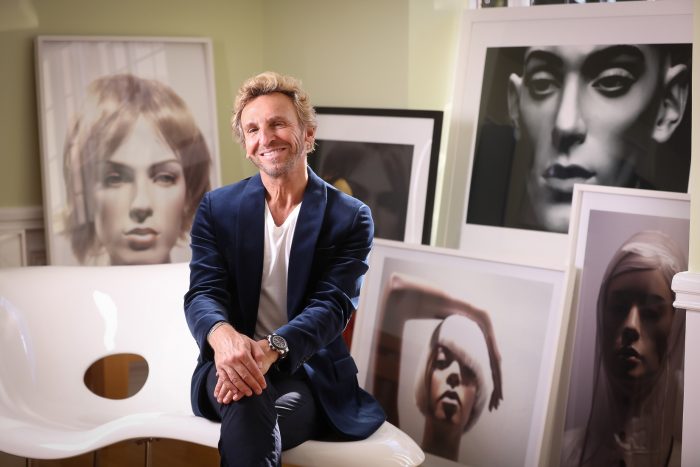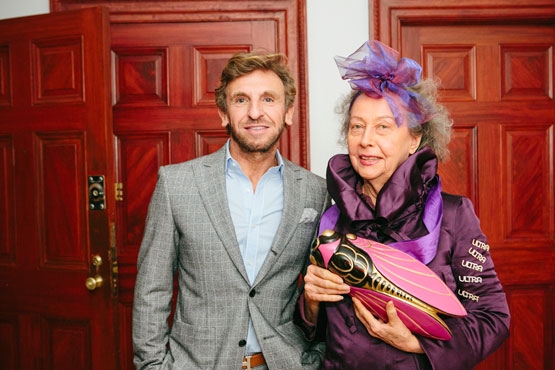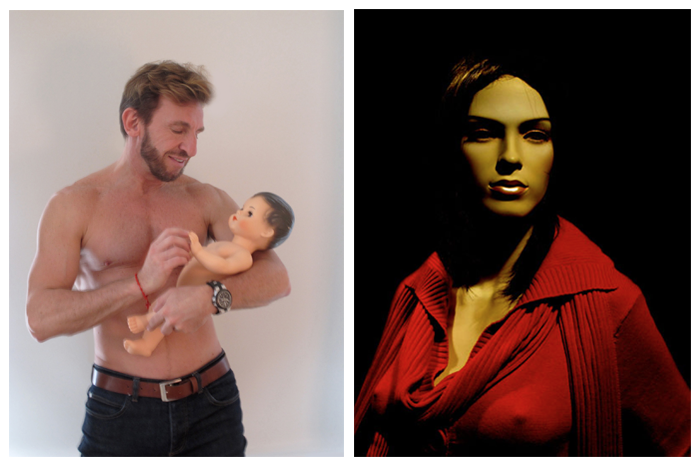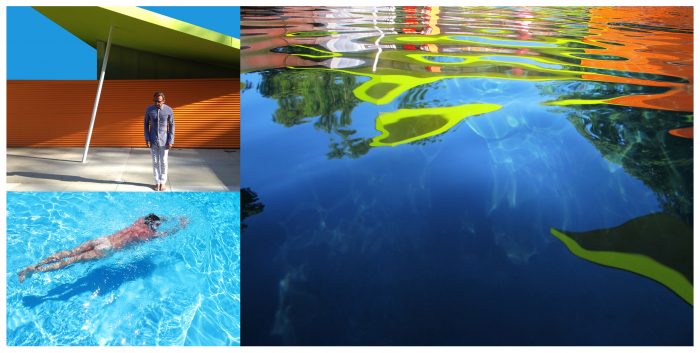The French artist on David Hockney, Ultra Violet and how America changed him

Pascal Blondeau in his studio at the French Ambassador’s residence (Photo by Tony Powell)
“You have to kill your father.”
It was this advice from his best friend and mentor Ultra Violet, the famous “superstar” artist/muse of Andy Warhol and Salvador Dalí, that changed the way Pascal Blondeau approached his art. The Warhol devotee realized that his work was actually closer to that of Dalí, and that he should embrace his surrealist inclinations.
Seven years later, Blondeau channeled that insight into a tribute to Ultra Violet (born Isabelle Dufresne), a multi-art performance blending song, dance, fashion and text, a departure from the portraiture he’s known for. Last October, “Only You Could Have a Face Like That” made its Washington debut at the Phillips Collection.
If you have been to the French ambassador’s residence, you’ve likely seen the work of Blondeau, 47, or met the artist himself. The longtime partner of Ambassador Gerard Araud is a force in his own right, an internationally renowned photographer whose work is sold by Sotheby’s New York and Paris. Recently, he showed at Art Basel Miami.
Born in Paris and raised on the Left Bank, Blondeau’s creative career began at a young age. He studied at the Ecole des Beaux-Arts, and then at Alice Dona’s competitive music school.

Pascal Blondeau and Ultra Violet in New York
Blondeau prefers to shoot with an old Pentax, and finds inspiration in all sorts of people. “I try to understand what is interesting in the face,” he says. Despite working for 20 years as a photographer in Paris, he says it wasn’t until he moved to New York in 2009 that he reached the height of his career success.
When he arrived in the city he knew no one, but soon met Ultra Violet at a party.
The two became inseparable – she introduced him to her New York art friends and they collaborated on multimedia shows together; she encouraged him to add performance to his exhibitions.
Blondeau speaks fondly of his friend, who died in 2014.
“I was in France for 40 years and my master was Andy Warhol. I never imagined I would actually meet someone from The Factory,” he says. “When I performed with her, I discovered new worlds. It’s very different to be on stage in the middle of your exhibition, surrounded by your pictures. It’s very intimate.”
Perhaps stepping out of his comfort zone is what Blondeau needed for his best art to emerge. He says moving to the U.S. changed both his work and the public reception of him.

From Left: “Single Man” (Self-Portrait by Pascal Blondeau), “The Lady in red” by Pascal Blondeau
It was very difficult to be an artist in France, he says. “Parisian people are very closed-off. In America it’s very different. Americans love the action. You meet someone interested in your work and they’ll call you the next day.
My work has to be alive and powerful all the time. I always have something to propose, and in America it’s ok to be like that.”
His work has always tackled the duality of human nature—the fact that, as Blondeau puts it, “we are awful animals who try to become nice.” That people are not always what they seem at first glance.
One popular series featured display mannequins and portraits of human subjects mixed together to achieve surprising results. One portrait appears to be a beautiful woman from a distance but upon closer glance is part plastic. In the one self-portrait in the series, Blondeau holds a plastic baby, a commentary on the status of gay marriage in France, and his own mixed feelings about having a child.
“With that series, I wanted to say that beauty is sometimes the first vision but the second time, there is a lot of terror,” he explains. “For me, that is a portrait of humanity, and it includes me.”

Image from “Swimming Pool – Tribute to david Hockney” by Pascal Blondeau
Aside from the portrait with the baby, Blondeau had been hesitant to turn the camera on himself, but once he branched into self-portraiture, his best work emerged. His “Swimming Pool” series pays tribute to the 1970s work of painter David Hockney. In each large, colorful photo, Blondeau announces himself to the world. In one photo, he’s standing on the edge of a swimming pool looking down at himself in the water.
The subject, he says, is his own narcissism.
“I’m happy I did that work about myself,” he says.
“For that, I can say thank you to America. It’s here that I’ve become another artist, one who is more open.
”
This story first appeared in the January/February 2017 issue of Washington Life.




